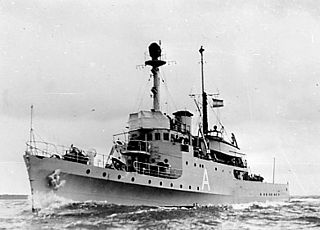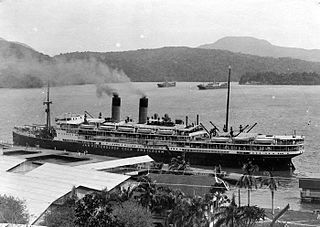
HNLMS Abraham Crijnssen is a Jan van Amstel-class minesweeper of the Royal Netherlands Navy (RNN).

HNLMS Van Speijk was a K-class sloop, designed in the late 1930s to replace the aging Brinio-class gunboats of the Royal Netherlands Navy. Incomplete at the start of the German invasion of the Netherlands and not yet launched, K3 was found undamaged by the German forces. The Kriegsmarine ordered her completion, then commissioned her for service in Norwegian and German home waters.

HNLMS Pieter de Bitter was a Jan van Amstel-class minesweeper of the Royal Netherlands Navy that served in World War II.

HNLMS Eland Dubois was a Jan van Amstel-class minesweeper of the Royal Netherlands Navy that served in World War II.

HNLMS Jan van Amstel was a Jan van Amstel-class minesweeper of the Royal Netherlands Navy that served in World War II.

HNLMS Jan van Gelder was a Jan van Amstel-class minesweeper of the Royal Netherlands Navy that served in World War II.

HNLMS Willem van Ewijck was a Jan van Amstel-class minesweeper of the Royal Netherlands Navy.

HNLMS Abraham van der Hulst was a Jan van Amstel-class minesweeper built for the Royal Netherlands Navy in the 1930s. The German invasion of the Netherlands resulted in the ship being scuttled at Enkhuizen on 14 May 1940, but was raised by the Germans and entered service as the minesweeper M 553 with Nazi Germany's Kriegsmarine. The vessel was sunk by a mine off East Prussia on 21 April 1944. M 552 was raised on 20 July 1944 and towed to Stettin. There, the ship was bombed and burned out 20 August 1944. The wreck was captured by the Soviets. One source says she was returned to the Netherlands post war.

HNLMS Abraham van der Hulst was a Jan van Amstel-class minesweeper of the Royal Netherlands Navy.

HNLMS Pieter Florisz was a Jan van Amstel-class minesweeper of the Royal Netherlands Navy and Nazi Germany's Kriegsmarine during World War II.

The Douwe Aukes class were two minelayers of the Royal Netherlands Navy. The two ships were built at the Gusto shipyard in Schiedam. Construction began in 1919 and was completed in 1922. Built to serve in the Dutch territorial waters, both ships were still in service during the Second World War and they both escaped to the United Kingdom, HNLMS Douwe Aukes on 14 May and HNLMS Van Meerlant on 18 May 1940. Both vessels were transferred to the British Royal Navy. Van Meerlant was sunk by a mine in 1942 while in British service. Douwe Aukes was returned to the Royal Netherlands Navy following the war and was used as a depot ship until sold for scrap in 1962.

The Élan class was a class of French minesweeping sloops. Originally designed as minesweepers, they were never used in that role, instead being used mostly as escort vessels. Built between 1936 and 1940, the first came into service just before the outbreak of World War II.
Two ships of the Royal Netherlands Navy have been named HNLMS Abraham Crijnssen, after the 17th century naval commander Abraham Crijnssen:

SS Jan Pieterszoon Coen was a Dutch passenger steamship that was launched in 1914. She was named after a former Governor-General of the Dutch East Indies. During the German invasion of the Netherlands in May 1940 she was scuttled as a blockship in the port of IJmuiden, North Holland to prevent the Kriegsmarine from using the port.
HNLMS Abraham van der Hulst may refer to following ships of the Royal Netherlands Navy:

The Type 1940 torpedo boats were a group of 24 torpedo boats that were intended to be built for Germany's Kriegsmarine during World War II. Although classed as fleet torpedo boats by the Germans, they were comparable to contemporary large destroyers. They were designed around surplus Dutch propulsion machinery available after the Germans conquered the Netherlands in May 1940 and were to be built in Dutch shipyards. Hampered by uncooperative Dutch workers and material shortages, none of the ships were completed before the Allies invaded Normandy in June 1944. The Germans towed the three ships that were most complete to Germany to be finished, but one was sunk en route by Allied fighter-bombers and no further work was done of the pair that did arrive successfully. The remaining ships in the Netherlands were later broken up for scrap and the two that reached Germany were scuttled in 1946.

The Goeree class was a ship class of ten minesweepers that served in the Royal Netherlands Navy (RNN) between 1947 and 1956. They were former R boats that served in the Kriegsmarine and German Mine Sweeping Administration. In 1947 they were transferred to the Netherlands as war reparations.
This page is based on this
Wikipedia article Text is available under the
CC BY-SA 4.0 license; additional terms may apply.
Images, videos and audio are available under their respective licenses.














